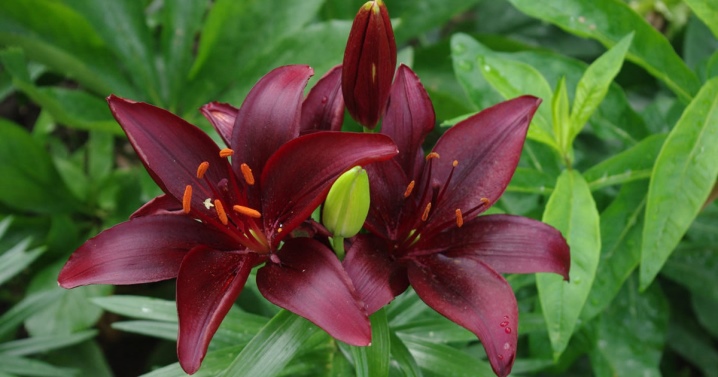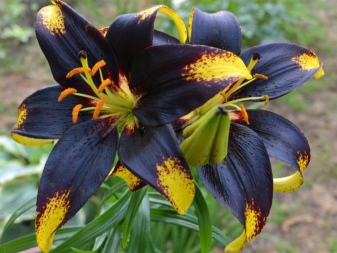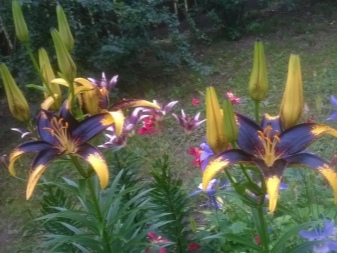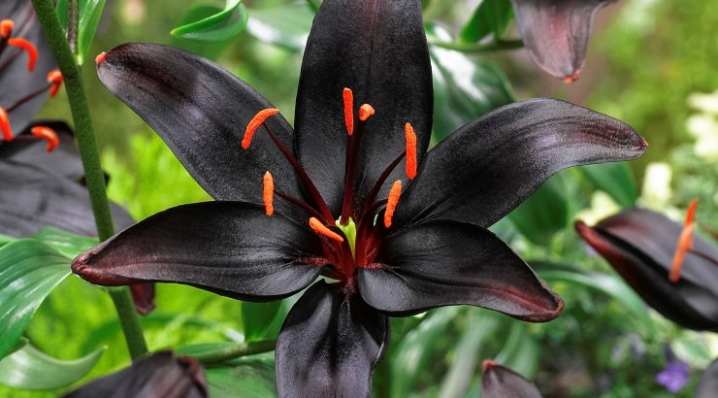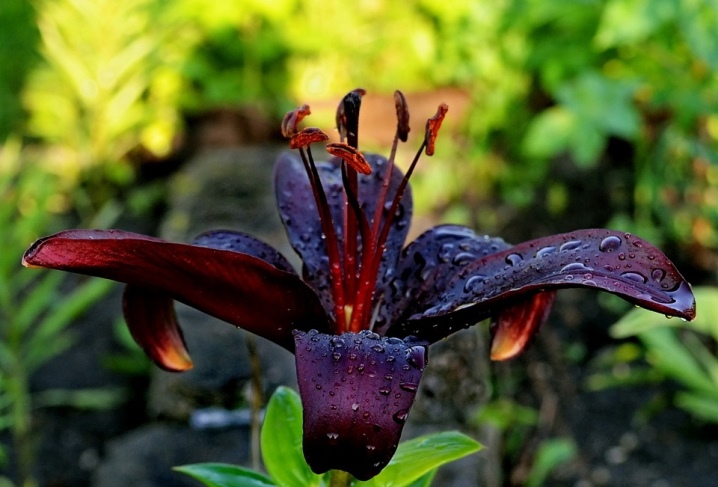How to plant lilies correctly in spring, summer and autumn
In accordance with the rules for growing these plants, planting can be performed in spring, summer, and autumn, depending on the species and variety. Spring is the right season for planting late blooming lilies, which are cared for first by mulching the soil with straw to protect it from frost. In spring, Tibetan, tiger, double lilies are planted - as soon as the air temperature stabilizes at 11 ° C. Asiatic tubular lilies are placed outdoors as soon as the snow melts.
The advantage of planting fall-blooming varieties in spring is that it can prevent freezing and soaking of bulbs that are in the ground in an open area in winter. In the spring months, more intensive root growth is observed, which means that the plants will be able to take root well.
Early flowering lilies are planted when the bulbs are ready to retire - in early autumn. The September planting of lilies in the open field with further care - mulching before winter - is recommended for curly, Canadian, one-brother lilies, Shovitz, Hanson, etc. But planting material is not always sold at this time. If the bulbs were purchased in spring, they must be stored at a temperature of + 1 ... + 2 ° C in moist moss or sawdust. The sprouts are planted in pots and placed in a bright, cool place. They will go to the garden only at the beginning of June.
The principles of how to properly plant lilies on a garden plot do not depend on the planting season - they are universal. Below are the main guidelines for experienced gardeners to consider when breeding these flowers.
Before planting any varieties of lilies, you need to decide on a place in the garden. The type and variety of the plant will become a guideline in this matter. For example, for Asiatic and Oriental lilies, areas with good lighting levels are best suited. Curly specimens, which have adventitious roots on the underground parts of the stems, are best planted in partial shade - the part at the root should be protected from direct sunlight, and the flowers, on the contrary, should be illuminated.
Since it is necessary to grow heat-loving lilies away from drafts, then a windless place for planting should be chosen, covered with a screen of other plants. It is better if these are small hills in the garden, so that moisture from precipitation does not collect in the holes and does not cause rot.
Planting depth depends not only on the size of the bulbs, but also on the characteristics of the variety.
|
Variety type |
Undersized |
Medium-sized |
Tall |
|
Bulb size |
|||
|
Large |
Planting depth - from 10 to 12 cm |
Planting depth - from 12 to 15 cm |
Planting depth - 15 to 20 cm |
|
Small |
Planting depth - from 7 to 8 cm |
Planting depth - 10 cm |
Planting depth - from 10 to 12 cm |
|
Distance between bulbs |
15 to 20 cm |
20 to 25 cm |
25 to 30 cm |
It should be borne in mind that the planting depth directly affects the beginning of flowering: the larger it is, the later the color appears. But a deeper placed onion is able to provide a larger number of children.
The step-by-step photo shows planting a lily and caring for it in the first time after planting - study the main nuances and take them into account in your gardening practice:
How to plant correctly
When to plant irises? Seat selection
Most gardeners believe that as soon as the irises have finished blooming, they should be dug up, divided and planted in a permanent place. Because otherwise, they may not have time to be taken before the onset of the winter period. However, if in your area there is a long and warm enough autumn, then you may not be in a hurry to transplant irises.Such flowers can actually be transplanted from spring to autumn, but only after they have finished their flowering period. Remember that irises should be replanted at least once every 3 or 4 years. However, Siberian irises can grow in one place for about 10 years. If you do not transplant, then the overgrown bushes stop blooming.
For bearded irises, you should choose a sunny place away from drafts, which should be located on a hill or on a slope, since it is very important that the place is well drained, and there is also an outflow of melt water. Disembarkation is recommended from morning to lunchtime
For the Siberian and marsh species, you need to choose places with wet soil. Absolutely all irises need nutrient-rich soil. To correct poor soil, before planting irises in spring, you need to add compost or garden fatty soil, as well as phosphorus-potassium fertilizer. It is recommended to add chalk, dolomite flour or wood ash to acidic soil. It is recommended to add sand and peat to loam, and clay soil to sandy soil. It is recommended to disinfect the soil before planting irises. To do this, it must be watered with a fungicide, and also treated with herbicides from weeds. You cannot bring manure into the ground.
How to plant irises. How to plant irises.
Spring planting
The purchased planting material, as well as the one that was stored throughout the winter period, must be treated with a growth stimulating agent (Zircon or Ecoel). If the roots are long, then they must be trimmed, places where there are traces of decay must be carefully cut out. The root should be dipped in a potassium manganese solution for a third of an hour for disinfection. Make a not very deep hole and pour sand into it with a mound. The rhizome of the bearded iris must be laid so that it is horizontal. Spread the roots and sprinkle the hole so that only the upper part of the rhizome remains above the soil surface. Then the iris should be watered abundantly. In the event that the entire rhizome is underground, then this, as a rule, leads to the appearance of rot. Beardless species, on the other hand, need to be buried a few centimeters into the ground. A layer of mulch (peat or fallen needles) should be poured on top, which will help retain moisture. The wells must be spaced from each other at a distance of at least 50 centimeters.
Autumn planting
Autumn planting is not much different from spring planting. It is recommended to be carried out at the end of the summer season, when the flowering period ends. As a rule, it is advised to transplant from August to the last September days, but it should be borne in mind that an earlier transplant will allow the plants to take root and grow stronger. Dig the bush with a pitchfork, then divide it into annual links with a leaf blade
The cord-shaped roots must be carefully shortened, remove those places where there is damage or traces of decay. Then the delenki must be placed in a dark pink solution of potassium manganese for 2 hours for disinfection.
After that, they need to be put in a sunny place for 4–5 hours. Delenki should be planted in the same way as in spring. A distance of about 50 centimeters should be left between the holes of high grades, between medium-sized ones - 20 centimeters, between undersized ones - 15 centimeters.
LA and OT hybrids: description, varieties
We recommend that you familiarize yourself
LA hybrids are perennial plants obtained by breeding in the 90s. The progenitors were two types of lilies: long-flowered and Asiatic. In their description, one can note larger flowers (17-25 cm in diameter), more often of a funnel-shaped tubular configuration, with an unobtrusive and stable aroma. The color scheme abounds in all shades, from versatile white to deep purple. Unlike Asian ones, they are endowed with stronger, erect stems.
They are appreciated by flower growers, especially in central Russia, for winter hardiness and unpretentious care, along with early flowering (comes 65-70 days after planting). Ideal for forcing, as they are adapted for short daylight hours in the autumn-winter period. After cutting, they remain fresh for about 12-15 days. They look no less impressive in gardens and parks, in combination with other perennial decorative crops.
The most beautiful varieties are shown in the table:
| Names | Description | Visual photo |
| Iceberg | The flowers are whitish-green in color, cupped, raised. Blossom in July in groups of 3-4 pieces on peduncles up to one meter high | |
| Vanilla | It has flat wide flowers of gentle pastel colors: white, cream, pink. The diameter when opened is about 17 cm. The petals are curved, fringed at the sides. Stems are erect, densely leaved, one meter in height | |
| Glow | Yellow representatives with large-scale inflorescences about 15-16 cm in diameter. It blooms in July, forming dense bundles of 5-6 buds on one peduncle. A little less than a meter tall | |
| Double Whiskey | With beautiful funnel-shaped flowers of a pleasant orange hue. Blooms in the middle of summer | |
| Royal Impulse | A variety from the category of orange lilies. Endowed with lush flowers, 15-17 cm in diameter, directed upwards. Form inflorescences of 6-7 pieces on strong stems, 100-110 cm high.Blooms at the end of June | |
| Royal Perfume | Another sunny specimen with graceful arched petals. Flowers are collected in inflorescences of 5-6 pieces | |
| Algarve | The flowers are light pink in color, cupped, erect, large (18-19 cm in diameter). 1 meter tall peduncles upright, with small narrow opposite leaves | |
| Coral Fashion | Blossom in July with red cupped flowers |
OT-hybrids or Orienpets are the result of crossing of oriental and tubular species lilies. Depending on the variety, they can grow over 1.5 meters in height. The characteristic feature is the maroon bulb. The stem is completely covered with buds, exuding a unique smell. These hybrids rarely get sick, they steadfastly endure a drop in temperature. Due to their tall growth in the garden, it is preferable to plant them in the background so that others do not obstruct.
The best varieties are shown in the table:
| Name | Description | Photo |
| Albania | The flowers are funnel-shaped, about 20 cm in diameter, with curved petals, drooping. The main background is white, inside there is a brown inclusion. In inflorescences are collected in 7-8 pieces. Stems extend up to 130 cm in height | |
| Shocking | The buds are large, with yellow-red petals. 100-110 cm high | |
| Queen Promis | Outwardly, they resemble large white-pink bells. The edges of the petals are lightened. Form inflorescences of 4-5 buds on peduncles, 130-140 cm high | |
| Manisa | They stand out in rich yellow flowers with a white border around the edge. Stem height - 120-130 cm |
Varieties
Black color is the main distinguishing feature of the "Landini" lily. This plant is characterized by a truly Gothic color, the petals have a deep, dark red hue, but under certain lighting they give the impression of almost black. This lily is one of the darkest of all liliaceae. Despite the unusual color scheme, "Landini" are very popular with gardeners and landscape designers.
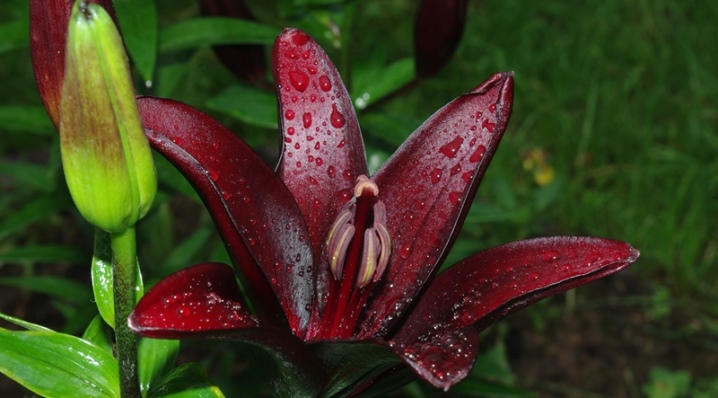
These flowers are quite unpretentious and can easily endure cold, prolonged winters. Plants grow best on calcareous soils, they do not like stagnant moisture, therefore lowlands and places with a high level of groundwater are not suitable for planting: excessive moisture is created there, which leads to the rapid wilting of the culture. The turban-shaped flowers grow up to 8-20 cm, directed downward, upward and to the sides. Several flowers form a paniculate inflorescence.
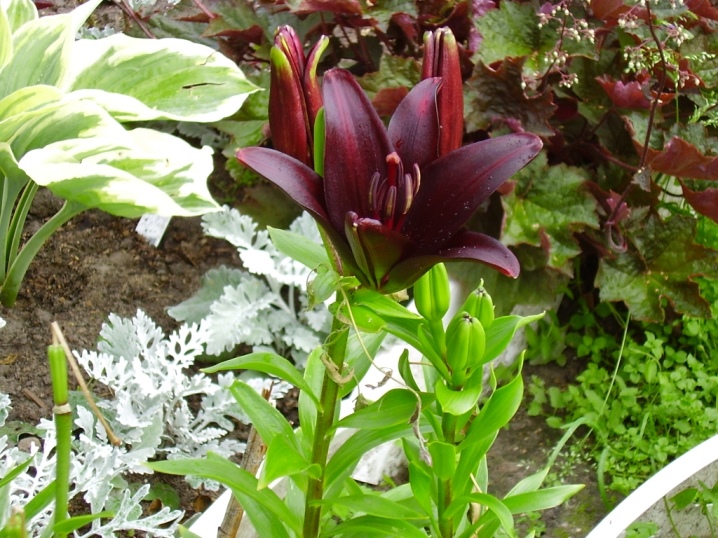
A black lily in the garden looks harmoniously surrounded by roses and peonies in contrasting shades.Some gardeners argue that "Landini" looks good on their own, but it is in contrast that these plants are especially rich and harmonious.
The following varieties are also referred to as "dark" lilies.
Lilia Mapira. This globular culture cannot be called pure black, it is more burgundy, with a rich dark center.
